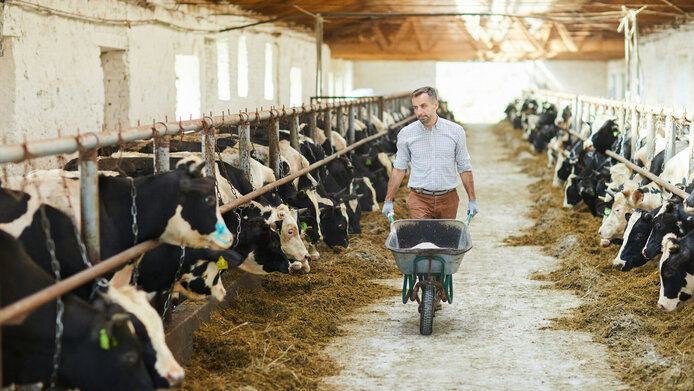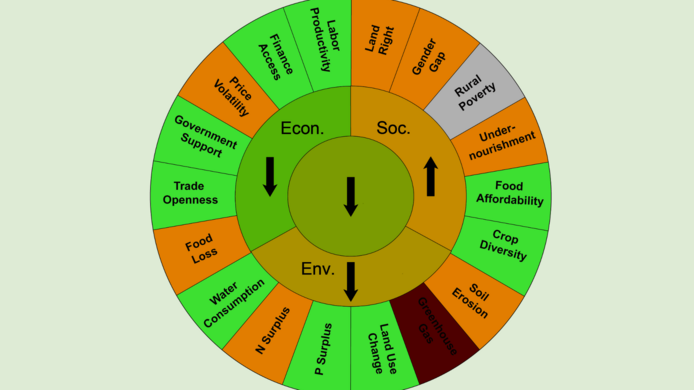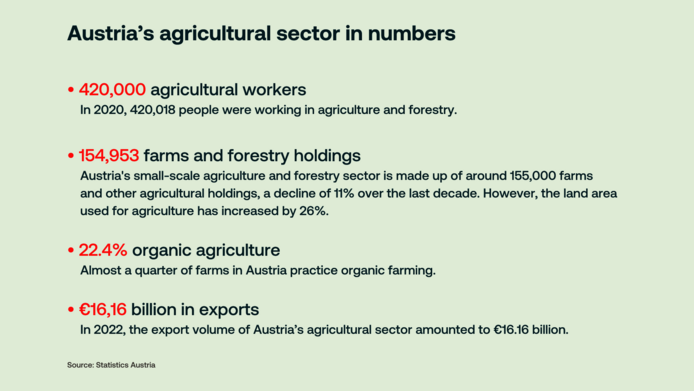How to measure the sustainability of Austrian agriculture?

What is sustainable agriculture? This question cannot be answered easily, for sustainability is multi-faceted, and agricultural production systems and trade are regionally diverse and globally connected. Environmental scientist Christian Folberth who conducts research at the International Institute for Applied Systems Analysis (IIASA), has nevertheless engaged to do just that. For the project, “Guiding Sustainability by a Sustainable Agriculture Matrix“, which ran from 2021 to 2023, he worked with international colleagues to answer the following questions: what constitutes agricultural sustainability in individual countries? And: how can this be measured? The project is funded by the Belmont Forum – an association of international research institutions of which the Austrian Science Fund FWF is also a member.
From India to the USA: an international concept
For the project, institutions (universities, NGOs and the private sector) from Austria, Brazil, Morocco, Turkey, the USA and South Africa collaborated under the leadership of a researcher from the University of Maryland. Alongside IIASA, the Austrian Institute of Economic Research (WIFO) was also involved, represented by Franz Sinabell.
Developed by the Indian agricultural scientist Monkombu Swaminathan, the Sustainable Agricultural Matrix (SAM) was used as an overarching concept for the project. “Swaminathan defined three dimensions: environmental, economic and social. He stated that you have to consider them all at the same time and also look at the interactions between them,” explains Christian Folberth.
In a previous project, a group of international research teams had identified six agricultural sustainability indicators for each of the three dimensions. The indicators are based on data from the United Nations (UN) or other international databases, and can be measured over longer periods of time in at least 120 countries. In this way, the interactions of the individual indicators can be explored.
What constitutes agricultural sustainability in individual countries? And how can this be measured? International research teams worked together with people from the field to develop an "Indicator matrix for agricultural sustainability" (2021-2023).
Sustainability in agriculture at a glance
“To provide an example: one indicator of the environmental dimension is the surplus of nitrogen fertilizer. The agricultural gross domestic product per person is an economic indicator, and access to land rights counts as a social indicator,” notes Christian Folberth.
This revised matrix can be represented as a circle with two outer ring layers. The 18 indicators are placed on the outermost ring and are shown in green, amber or red – depending on whether predefined threshold values are exceeded and, if so, to what extent. The inner ring shows the three dimensions in the color corresponding to the values of the respective indicators. The color within the central circle represents the country’s overall agricultural sustainability level. While the matrix thus illustrates the performance of a country in the various areas, it also has weaknesses.
From research to practice
“As a rule, agricultural sustainability indicators such as SAM are developed by international organizations or in academia,” says Folberth. He and his colleagues wanted to find out whether the matrix also works in the respective countries. “To do this, we used a bottom-up approach and obtained the opinions of expert practitioners from the respective field,” Folberth explains.
The researchers brought together representatives from 14 agricultural stakeholders for two workshops. The participants were (part-time) farmers, representatives from the private sector, NGOs, authorities, the Chamber of Agriculture or educational institutions. They helped to assess the practical applicability of the 18 indicators for Austria.
“It was exciting to see what happens when our top-down approach meets the reality of agriculture on the ground. The feedback we received was critical, and thus all the more relevant,” recounts Christian Folberth, who was very impressed by the expertise of the invited stakeholders.
Improvements needed
One of the issues criticized by the local experts concerned so-called aggregated figures, for example for labor productivity. “It is calculated by dividing the agricultural gross domestic product by the number of people working in agriculture,” explains Folberth. What this value does not show, however, is the areas in which people are becoming more productive, or whether the number of people working in agriculture is going down, as is the case in Austria. In this way, the researchers learned from the stakeholders what indicators or data are relevant for statements on agricultural sustainability in the respective countries.
In many tropical countries, the deforestation rate is very indicative of agricultural sustainability in terms of biodiversity. “In Europe, on the other hand, local biodiversity is a much more important indicator,” explains Christian Folberth.
Also, the limit values set for the indicators would need to be adapted to the individual countries. The upper limit for nitrogen surplus, which is 50 kilograms per hectare, is far too high to be acceptable in European Union member states according to EU regulations.
Regional adjustments
From the collaboration with stakeholders, the researchers have collected more than 30 suggestions for suitable local indicators. One example: in Austria, the number of farms where a successor exists who can carry on the undertaking says a great deal about social sustainability. The researchers aligned these suggestions with the available data. After all, global data and long time series are needed in order to be internationally comparable.
One year after the first workshop, the researchers had another round of meetings with the practitioners. “We wanted to assess whether the scientific findings from the first workshop were actually relevant,” explains Folberth.
The question remains: what are the specific advantages of regional adaptations? An agricultural sustainability matrix that is adapted to the local situation reveals correlations. “For example, this enables us even today to model scenarios that show how environmental indicators change when there are economic changes and vice versa,” says Folberth. The matrix can thus serve as a tool for policy-makers.
What happens next?
The researchers are currently publishing their findings. “We hope to be able to build on this research,” emphasizes Folberth. It would be conceivable, for instance, to adapt the matrix regionally. The ring with the 18 global indicators could be surrounded by another ring with regional indicators. Suitable data series for this purpose are available – for instance in respect of the factor of agricultural land being converted into other types of use.
Accordingly, there is still a lot of progress to be made. The feedback from stakeholders was nevertheless positive, says Folberth: “Many of them appreciated the fact that someone has developed an internationally comparable indicator system and now wants to adapt it to practical requirements.” Hence, the collaboration between researchers and practitioners has been fruitful for both sides.
Personal details
Christian Folberth is a Senior Research Scholar in the Agriculture, Forestry and Ecosystem Services Research Group at the International Institute for Applied System Analysis (IIASA). He studied horticultural sciences as well as environmental planning and engineering ecology at the Munich University of Technology and, in 2014 obtained his PhD at the Department of Environmental Systems Science at ETH Zurich. The international project “Guiding Sustainability by a Sustainable Agriculture Matrix” (2021–2023) received roughly EUR 71,000 in co-funding from the Austrian Science Fund FWF.
Publications
Folberth C., Wood S.A., Wironen M. et al.: Exploring the potential for nitrogen fertilizer use mitigation with bundles of management interventions, in: Environmental Research Letters 19, 2024
Folberth C., Sinabell F., Schinko T., & Hanger-Kopp S.: Co-evaluating and -designing a Sustainable Agriculture Matrix for Austria in an international context, in: EGU General Assembly 2022
Zhang X., Yao G., Vishwakarma S. et al.: Quantitative assessment of agricultural sustainability reveals divergent priorities among nations, in: One Earth 4, 2021







